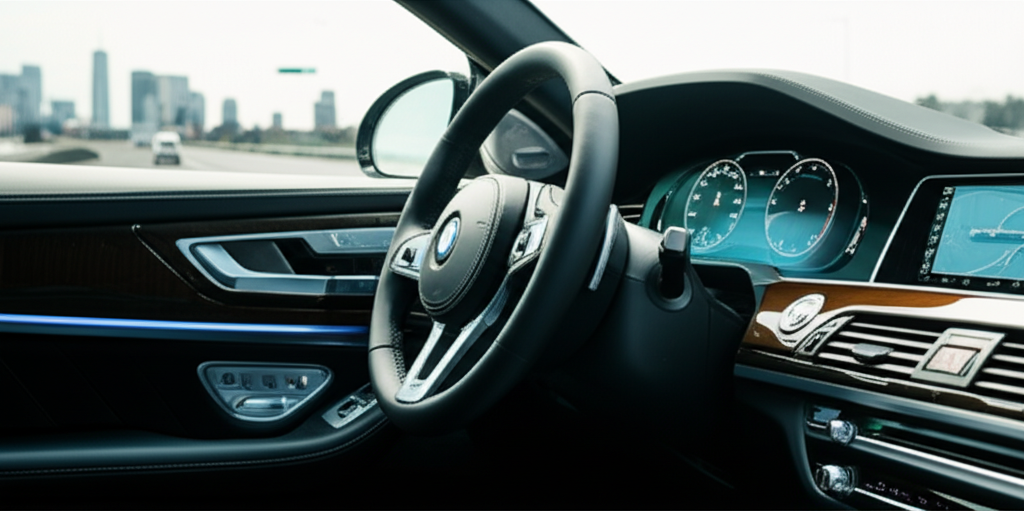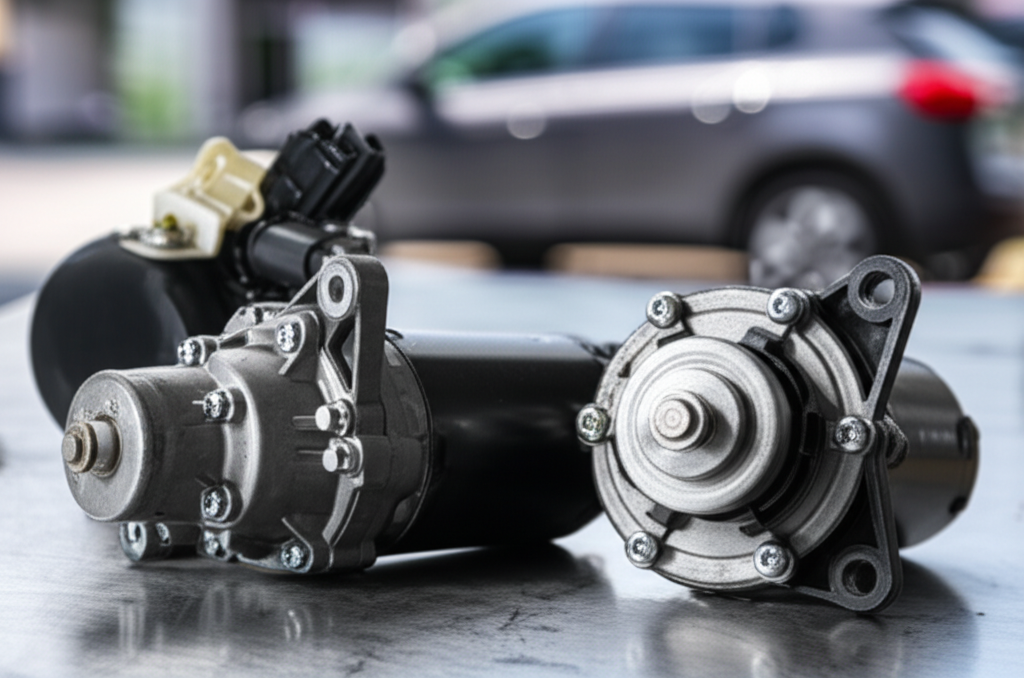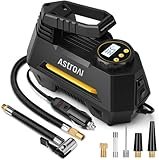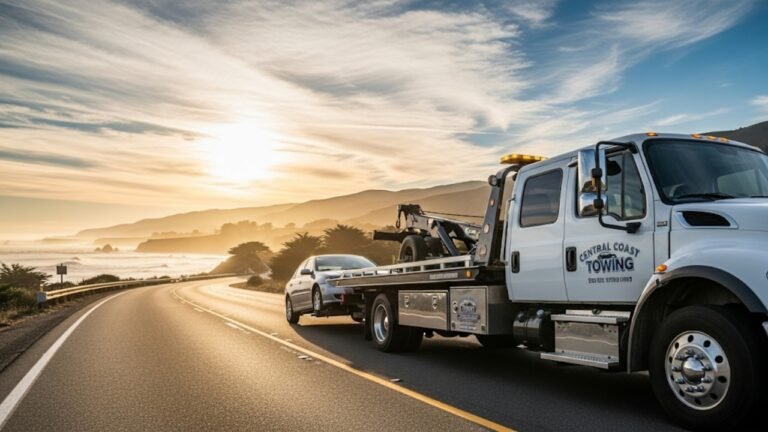5 Powerful Car Wiper Motor Specifications Explained

Unlock the secrets to powerful car wiper motor performance with this beginner-friendly guide explaining 5 key specifications. Understand what matters for clear visibility in any weather, ensuring your safety and confidence on the road.
Key Takeaways
- Understand voltage, current, and power ratings for wiper motors.
- Learn about torque and speed as crucial performance indicators.
- Discover the importance of duty cycle and thermal management.
- Explore gear reduction ratios for optimal wiper arm movement.
- Recognize the impact of environmental factors on motor longevity.
When rain, snow, or even dirt obstruct your view, your car’s windshield wipers are your first line of defense. But what makes those wipers move with such determined force? It’s the car wiper motor, a vital component often overlooked until it stops working. Understanding its specifications can seem daunting, but it’s key to ensuring your wiper system performs reliably. This guide breaks down the five most powerful car wiper motor specifications, making them simple and clear for any car owner. Let’s dive into what makes your wipers work effectively and how to spot potential issues.
What is a Car Wiper Motor and Why Specs Matter?

Your car’s wiper motor is a small but mighty electric motor responsible for moving your windshield wiper arms back and forth. Its primary job is to clear your windshield of precipitation and debris. When this motor falters, visibility plummets, directly impacting your safety. For drivers in the USA, where weather can change rapidly, a well-functioning wiper system is non-negotiable. Understanding the specifications of this motor helps you appreciate its engineering, diagnose problems, and make informed decisions if replacement is ever needed. Knowing these details ensures you can drive with confidence, no matter the weather.
1. Voltage and Current Draw: The Power Behind the Sweep
Every electric motor needs power to operate, and for car wiper motors, this power comes from your car’s electrical system. The two most fundamental specifications are voltage and current draw.
Voltage
Most car wiper motors in the United States operate on a 12-volt DC (Direct Current) system, standard for automotive applications. This voltage is supplied by your car’s battery and alternator.
- Standard Voltage: Typically 12V DC.
- Consistency: The voltage should remain relatively stable during operation, though it can fluctuate slightly with engine RPM.
Current Draw
This refers to the amount of electrical current (measured in amperes or amps) the motor consumes when operating. The current draw can vary depending on the wiper speed setting and the load on the motor (like clearing thick snow).
- Low Speed: Draws less current.
- High Speed: Draws more current.
- Stalled/Stuck: Draws the highest current, which can potentially blow a fuse or damage the motor if prolonged.
Why it Matters for You
Knowing the voltage helps confirm you’re dealing with a standard automotive motor. The current draw is crucial for diagnosing issues. If your wipers are sluggish, it might indicate the motor is drawing too much current due to internal wear or an obstruction. Conversely, a motor drawing significantly less current than expected might be failing internally or have a poor electrical connection. Understanding your car’s electrical system, often detailed in your owner’s manual, is part of safe driving in the USA.
2. Power Output (Watts): The Muscle of Your Wipers

Power output, measured in watts (W), is a direct indication of how strong the motor is. It’s calculated by multiplying the voltage by the current draw (Power = Voltage × Current). A higher wattage generally means a stronger motor, capable of moving the wiper arms more effectively, especially under load.
Typical Power Ratings
Wiper motor power ratings can vary significantly between vehicles, often ranging from 10 to 30 watts for typical passenger cars, and potentially higher for larger trucks or SUVs that require larger, more robust wiper blades.
Why it Matters for You
A higher power output is essential for:
- Heavy Weather: Efficiently clearing snow, ice, or heavy rain.
- Larger Wipers: Moving longer wiper blades with greater resistance.
- Durability: A motor with adequate power is less likely to strain and overheat, leading to a longer lifespan.
If your wipers struggle in anything more than light rain, the motor’s power output might be insufficient for the tasks or the motor itself may be weakening.
3. Torque and Speed: The Dynamics of Motion
Torque and speed are two critical specifications that describe how the motor performs its task. They are intrinsically linked: a motor might be fast, but weak, or slow but powerful.
Torque
Torque is the rotational force the motor can produce. It’s often measured in Newton-meters (Nm) or pound-feet (lb-ft). For wiper motors, torque is essential for overcoming the resistance of the wiper blades against the windshield, especially when they hit a patch of ice or thick grime.
High Torque: Means the motor can exert a strong turning force.
Low Torque: Means the motor may struggle to move the wipers under load.
Speed (RPM)
This refers to how fast the motor’s shaft rotates, measured in revolutions per minute (RPM). Wiper motors are designed for specific operating speeds that translate to effective wiper arm movement.
Motor RPM: The raw speed of the motor shaft.
Wiper Arm Speed: The effective speed of the wiper blades across the windshield, which is determined by the motor’s RPM and the gear reduction ratio (explained next).
Why it Matters for You
A balanced combination of torque and speed is crucial. You need enough torque to push the blades through tough conditions and enough speed (translated to the wiper arms) to clear the windshield effectively in a reasonable amount of time. If your wipers seem to move slowly and weakly, both the torque and speed specifications might be compromised due to motor wear.
4. Gear Reduction Ratio: Amplifying Force, Controlling Speed
Wiper motors rarely connect directly to the wiper arms. Instead, they use a gearbox with a gear reduction system. This system’s primary function is to:
- Increase Torque: By reducing the rotational speed, the gearbox multiplies the motor’s inherent torque. This is vital for overcoming the friction and resistance the wiper blades encounter.
- Control Speed: It slows down the fast-spinning motor shaft to a speed appropriate for the wiper arms to sweep across the windshield effectively without being too jerky or too slow.
Understanding the Ratio
A gear reduction ratio of, for example, 50:1 means that for every 50 revolutions of the motor shaft, the output shaft of the gearbox (which drives the wiper mechanism) rotates once. A higher ratio generally means more torque but slower output speed.
Why it Matters for You
The gear reduction ratio is engineering that allows a relatively small, efficient electric motor to generate the necessary force to move heavy-duty wiper arms. If the gearbox wears out or its gears become stripped, you might experience inconsistent wiper movement, a grinding noise, or the wipers stopping altogether, even if the motor itself is still functioning.
5. Duty Cycle and Thermal Management: Endurance and Longevity
The duty cycle and how the motor manages heat are critical for its long-term reliability.
Duty Cycle
This specification indicates how long the motor can operate continuously before needing to cool down. Wiper motors are not designed for constant, prolonged operation like, for instance, a radiator fan. They are meant for intermittent use.
Intermittent Operation: Most wiper motors have a duty cycle that allows them to operate for short periods with pauses in between.
Continuous Operation: Running the wipers continuously for extended periods (e.g., driving through a very long, intense snowstorm without turning them off or pausing) can cause them to overheat.
Thermal Management
This refers to how the motor dissipates heat generated during operation. Motors have built-in mechanisms or housings designed to help them cool down.
Overheating: If a motor overheats, its internal components can degrade, leading to reduced performance or complete failure. This is why sometimes, letting the wipers rest for a few minutes can temporarily solve a sluggishness issue caused by heat buildup.
Why it Matters for You
Understanding the duty cycle helps you use your wipers appropriately. While modern wiper motors are quite robust, avoiding prolonged, continuous use during extreme conditions (beyond what’s necessary) can extend their life. If you notice your wipers slowing down significantly during long periods of use, especially in hot weather, it could be a sign of thermal issues. Proper maintenance, like ensuring the wiper linkage isn’t binding and the blades aren’t excessively stiff, also reduces the load and heat generated by the motor.
Table: Wiper Motor Specifications Overview
To help you visualize these crucial specs, here’s a quick rundown:
| Specification | Unit of Measurement | What it Means | Impact on Performance |
|---|---|---|---|
| Voltage | Volts (V) | Electrical potential supplied to the motor. | Ensures compatibility with the vehicle’s electrical system. |
| Current Draw | Amperes (A) | Amount of electricity the motor consumes. | Indicates motor load; high draw can signal problems. |
| Power Output | Watts (W) | Total electrical energy converted into mechanical work. | Determines the motor’s strength and ability to clear obstructions. |
| Torque | Nm or lb-ft | Rotational force generated by the motor. | Enables wipers to overcome resistance from snow, ice, or debris. |
| Speed | RPM (Revolutions Per Minute) | Rotational speed of the motor shaft. | Affects how quickly wiper arms sweep the windshield. |
| Gear Reduction Ratio | Ratio (e.g., 50:1) | Mechanical advantage to increase torque and decrease speed. | Allows a smaller motor to move wiper arms effectively. |
| Duty Cycle | Percentage or Time | Duration motor can operate before overheating. | Relates to continuous operation capability and motor longevity. |
Pro Tips: Keeping Your Wiper Motor Healthy
Regular Blade Replacement: Old, cracked, or stiff wiper blades create more drag, putting extra strain on your wiper motor. Replace them every 6-12 months.
Clear Ice and Snow: Manually remove heavy ice and snow from your windshield before activating the wipers. This prevents the motor from being overworked and potentially freezing or stalling.
Lubricate Linkage (If Accessible): Occasionally, the mechanical linkage that connects the motor to the wiper arms can become dry or corroded, causing resistance. If you can access it safely, a little lubricant can help.
* Check for Obstructions: Ensure no leaves, debris, or foreign objects are preventing the wiper arms from moving freely.
Common Wiper Motor Issues and What They Mean
Understanding these specifications also helps in diagnosing common problems:
1. Wipers Won’t Move at All
This could be a blown fuse, a faulty switch, a disconnected wire, a damaged wiper linkage, or a completely dead motor. If the motor isn’t humming or attempting to move, it points to a power supply issue or a motor failure.
2. Wipers Move Slowly or Weakly
This often indicates a motor that is struggling. Potential causes include:
- Low voltage supply.
- Motor internal wear, leading to reduced torque.
- Binding in the wiper linkage.
- A weak or failing motor.
3. Wipers Move Intermittently or Unevenly
This might suggest issues with:
- The motor’s internal components are failing.
- The gearbox is slipping or damaged.
- Electrical connection is intermittent.
- The wiper park mechanism (which returns wipers to the base) is faulty.
4. Grinding or Loud Noises
This is typically a sign of mechanical problems within the gearbox. Stripped gears or debris in the gear mechanism can cause these sounds. It often means the motor needs replacement or repair.
5. Wipers Only Work on High Speed
This commonly points to a problem with the internal resistor or circuitry within the motor that controls different speed settings. The high-speed circuit, which often bypasses resistors, might be the only functional part.
External Resources for Wiper System Maintenance
For more in-depth information on maintaining your car’s wiper system, including troubleshooting and replacement guides, consult resources like:
- NHTSA (National Highway Traffic Safety Administration): For safety standards and recalls related to vehicle components, including visibility systems. Visit nhtsa.gov.
- Your Vehicle’s Owner’s Manual: This is the definitive guide for your specific car model, often containing maintenance schedules and basic troubleshooting tips.
- Reputable Automotive Repair Websites: Sites like RepairPal or forums dedicated to your car make can offer real-world advice.
Frequently Asked Questions (FAQ) About Car Wiper Motors
Q1: How often should I replace my car’s wiper motor?
A: Car wiper motors are designed to last for many years, often the lifetime of the vehicle. They don’t have a set replacement interval like wiper blades. Replacement is typically only needed if the motor fails or exhibits significant problems.
Q2: Can I replace a car wiper motor myself?
A: Yes, for many vehicles, replacing a wiper motor is a DIY-friendly task. It usually involves accessing the motor from under the dashboard or cowl panel, disconnecting electrical connectors, unbolting the old motor, and installing the new one. Always consult your car’s repair manual or a reliable online guide for your specific model.
Q3: What causes a car wiper motor to burn out?
A: Common causes include running the wipers continuously for too long, allowing ice or heavy debris to jam the blades, a failing motor with worn internal components, or electrical issues like a short circuit.
Q4: My wipers are acting erratically. Could it be the wiper switch instead of the motor?
A: Yes, it’s possible. A faulty wiper switch can cause intermittent operation, different speeds not working, or wipers not working at all. Diagnosing whether it’s the switch or the motor often requires testing the electrical signals.
Q5: How do I know if my wiper motor is failing?
A: Signs of a failing wiper motor include slow or weak wiper action, uneven or erratic movement, grinding noises, or the wipers working only on certain speed settings or not at all.
Q6: What’s the difference between a wiper motor and a wiper transmission (linkage)?
A: The wiper motor provides the rotational power. The wiper transmission, also called the linkage, is the mechanical assembly of rods and arms that converts the motor’s rotation into the back-and-forth sweeping motion of the wiper blades. Both can fail.
Conclusion
Understanding the five key specifications of your car’s wiper motor—voltage, current draw, power output, torque and speed, and gear reduction ratio—empowers you to appreciate this essential component’s engineering. These specs aren’t just numbers; they represent the performance and reliability that keep your vision clear in challenging driving conditions. By knowing what these specifications mean and recognizing the signs of potential issues, you can ensure your vehicle remains a safe and dependable companion on the road. A properly functioning wiper system is a testament to the robust engineering found in American automotive design, contributing to a safer, more confident driving experience for everyone.





